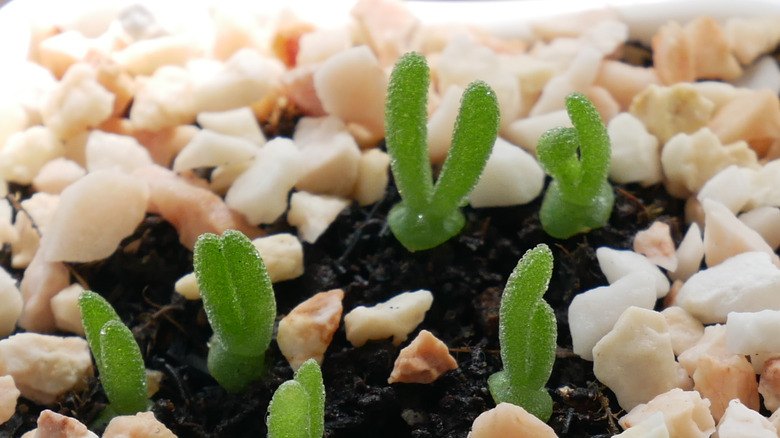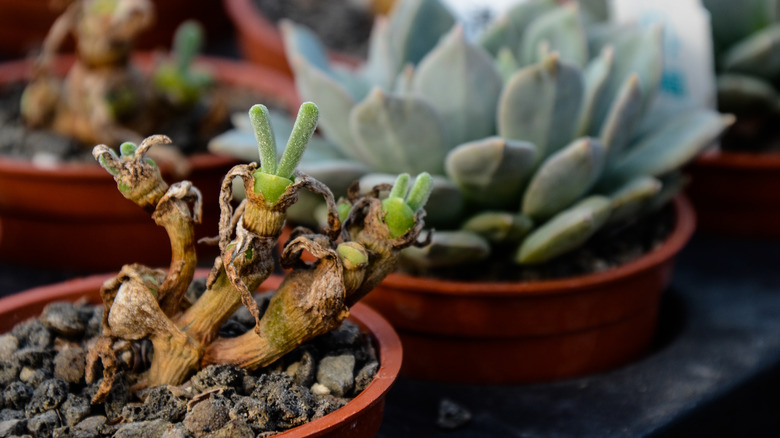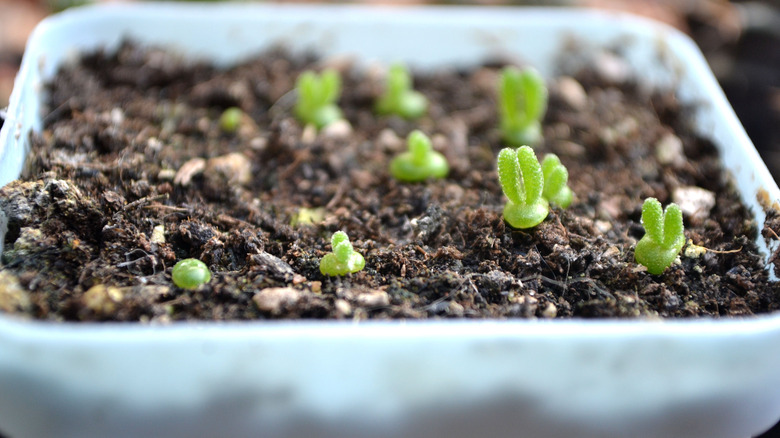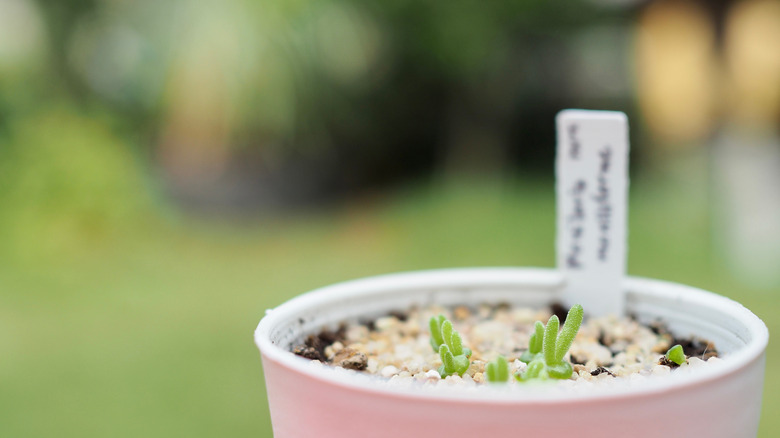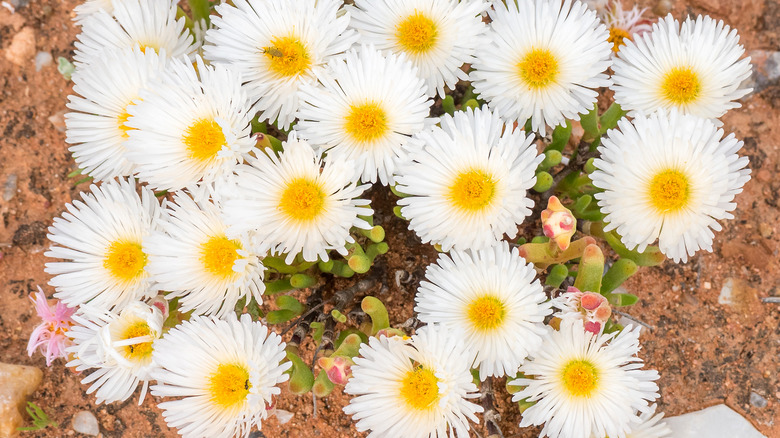How To Care For A Bunny Succulent
Bunny succulents (scientific name: Monilaria moniliforme or Monilaria obconica) were once more popularly called String Of Pearls thanks to the stacked, beaded look of their stems, says Wide Open Eats. Now the tiny plants have taken social media by storm with the moniker that better highlights their most adorable asset -– sprouting bunny ears.
Bunny succulents like to grow in clumps, with early buds that sprout in a rounded, fuzzy pairing that resembles baby bunny ears. According to Succulent Thrive, these sprouts eventually grow and produce flower blooms as well as leaves that will turn red if exposed to enough sunlight. They originate from Namaqualand, South Africa, growing on rocky soil on the sides of mountains, but yours will likely reward you with especially pretty blooms if you keep them in a tiny but relatively deep pot with good drainage. The bunny succulent height tops out around 8 inches tall, and although they are a little fussier than typical succulents, they are still easy to maintain. Keep reading for a guide on how to grow your own cluster of these truly unique plants.
How To Use Bunny Succulents In A Garden
Bunny succulents make great filler for any garden that has plenty of light and gets consistently warm temperatures, says Succulent Thrive. Your bunny succulent can be potted with other succulents with similar easy-drain soil and watering needs, but frankly, they would rather stick to a pot all to themselves.
According to My Life Is Peachy, your bunny succulent will likely grow in a cluster of three stems, which are thick, and will rise up out of the soil with a woody caudex that looks like stacked mini stones or beads. Keep in mind the bunny succulent will not stay cute and fuzzy (or tiny, for that matter) forever. Their early fuzzy bunny ears eventually grow out like long string beans. Add to that a big pink-white flower bloom that will protrude when it opens, so position your pot for your bunny ear succulent to stretch and grow in this way. The process is slow, so you have time to adjust.
You will want your bunny succulents featured prominently when budding or in bloom, but you may want to tuck them back a bit in their dormant season since their look goes from sweet, unique, and pretty to a sad lifeless stump, says RayaGarden. Even so, they bounce back so long as you avoid watering them much through their dormant summer months and also move the bunny succulent pot somewhere shady and temperate until winter, when their growing season picks back up with aplomb.
How To Grow Bunny Succulents
According to Succulent City, bunny succulents like a soil mix that gives their roots room to develop and drains easily. Your bunny succulent favors a small pot but deep enough for their long roots and would rather not be repotted any time soon, if ever. You can buy a commercial cactus mix or make your own, gardening store owner and Instagram plant guru @highway92succulents explained. Via Direct Mail, she walked us through her soil mix, which includes 2/3 good quality potting soil (like Miracle Grow or equivalent) modified with 1/3 perlite or volcanic pumice.
Start your bunny succulent from seed or purchase as mature plants, though those can be hard to find, says The Spruce. Growing from seed takes a real commitment, as it can be several years before the plant starts to resemble the bunny ears that gardeners love. However, the novelty of this plant is worth the work.
Start with a pot that has a hole in the bottom for easy drainage, and use a succulent soil mix. Use any gardening tool or your finger to poke holes into the soil around 2 inches apart and drop in seeds into the soil, says Grow Gardener. If starting from a bunny succulent clipping, plant the succulent into a shallow dish with a soil mix that has been soaked with water. Wrap the dish in plastic for two weeks before planting that cutting into its long-term pot. The key to early growth is to avoid overwatering your baby bunny succulent.
How To Care For Bunny Succulents
According to Kellogg Garden Products, compared to other succulents, bunny succulents can be a bit more temperamental. They like a lot of light that is largely indirect, rather than bathing in the sun as some other succulents like to do. Also, unlike other succulents, bunny succulents are dormant in summer, so their heavy watering time and potential fertilizing time will be through the winter months.
Bunny succulents love a sunny window seat, so long as it is not sunny all day and offers lots of air ventilation. If you are careful to protect your bunny succulent from direct sunlight, you can get by on very minimal watering, says RayaGarden. Since the bunny succulent stores water in its leaves and stem, you can wait to water until the soil feels half dry in winter, possibly around once a week, depending on other variables like the size of your pot. You may occasionally spray the topsoil of your plant through the summer months when your bunny succulent is dormant.
As much as possible, refrain from repotting your bunny succulent, says Succulent Thrive. They like to grow in the same pot for years.
Varieties Of Bunny Succulents
Bunny succulents come from the Monilaria genus, which is a deciduous plant native to Vanrhynsdorp and Verdendal districts on the southern tip of Namaqualand, South Africa, says The PathosBay. Although a few succulents can have toxic saps or skins, bunny succulents do not make Succulent Plant Care toxic list.
According to Succulent Alley, Monilaria belongs to the Mesembryanthemaceae (Aizoaceae) family. The species within this genus have leaves and stems, form in clusters and seasonally shed their leaves. They grow longer roots than other succulents and are dormant in summer.
Monilaria has 16 types of species. The two that look like bunny ears are Monilaria obconica and Monilaria moniliformis. The rest of the species of plants within the Monilaria genus include:
- Monilaria chrysoleuca
- Monilaria globosa
- Monilaria luckhoffii
- Monilaria microstigma
- Monilaria peersii
- Monilaria pisiformis
- Monilaria polita
- Monilaria primosii
- Monilaria ramulosa
- Monilaria salmonea
- Monilaria scutata
- Monilaria vestita
- Monilaria watermeyeri
- Monilaria brevifolia
When searching for your bunny succulent seeds or resourcing a starter plant, be sure not to confuse your bunny succulent for a similarly nicknamed plant called the succulent rabbit ear or bunny ear cactus. Although that is a succulent, House Plants Expert will assure you that the plant is cactus through and through and nothing like the sweet baby bunny ears of Monilaria moniliformis. Follow these tips and enjoy your own cluster of the distinctive bunny succulent plant.
